Regulatory T Cells - China Tregs 2008 Conference
advertisement
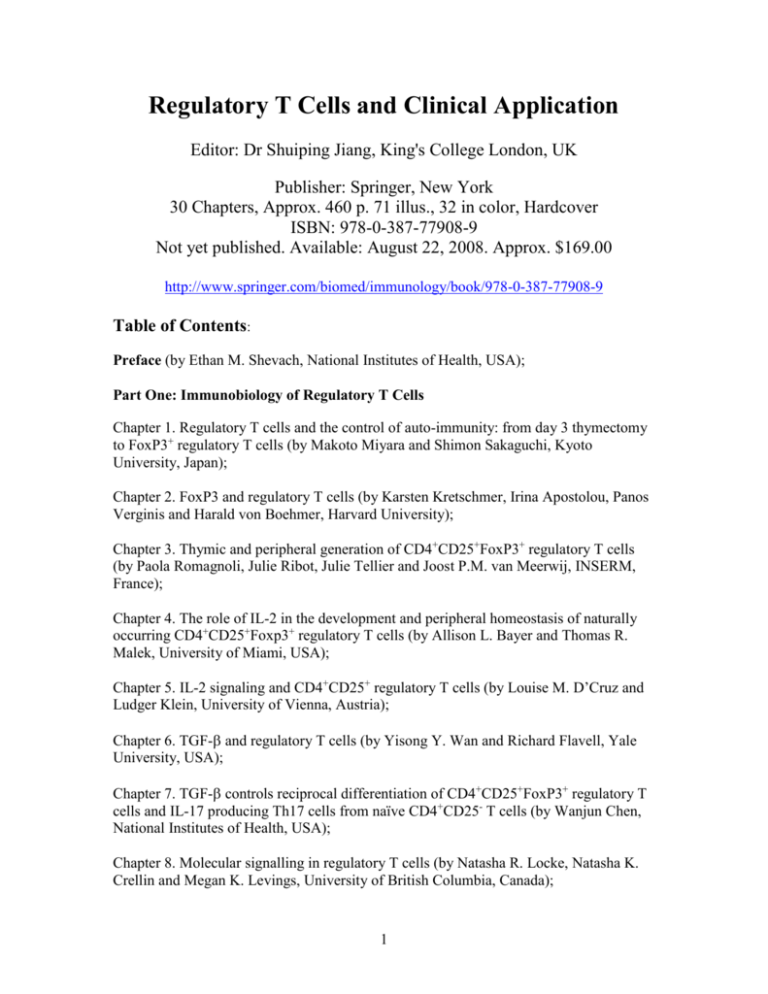
Regulatory T Cells and Clinical Application Editor: Dr Shuiping Jiang, King's College London, UK Publisher: Springer, New York 30 Chapters, Approx. 460 p. 71 illus., 32 in color, Hardcover ISBN: 978-0-387-77908-9 Not yet published. Available: August 22, 2008. Approx. $169.00 http://www.springer.com/biomed/immunology/book/978-0-387-77908-9 Table of Contents: Preface (by Ethan M. Shevach, National Institutes of Health, USA); Part One: Immunobiology of Regulatory T Cells Chapter 1. Regulatory T cells and the control of auto-immunity: from day 3 thymectomy to FoxP3+ regulatory T cells (by Makoto Miyara and Shimon Sakaguchi, Kyoto University, Japan); Chapter 2. FoxP3 and regulatory T cells (by Karsten Kretschmer, Irina Apostolou, Panos Verginis and Harald von Boehmer, Harvard University); Chapter 3. Thymic and peripheral generation of CD4+CD25+FoxP3+ regulatory T cells (by Paola Romagnoli, Julie Ribot, Julie Tellier and Joost P.M. van Meerwij, INSERM, France); Chapter 4. The role of IL-2 in the development and peripheral homeostasis of naturally occurring CD4+CD25+Foxp3+ regulatory T cells (by Allison L. Bayer and Thomas R. Malek, University of Miami, USA); Chapter 5. IL-2 signaling and CD4+CD25+ regulatory T cells (by Louise M. D’Cruz and Ludger Klein, University of Vienna, Austria); Chapter 6. TGF- and regulatory T cells (by Yisong Y. Wan and Richard Flavell, Yale University, USA); Chapter 7. TGF- controls reciprocal differentiation of CD4+CD25+FoxP3+ regulatory T cells and IL-17 producing Th17 cells from naïve CD4+CD25- T cells (by Wanjun Chen, National Institutes of Health, USA); Chapter 8. Molecular signalling in regulatory T cells (by Natasha R. Locke, Natasha K. Crellin and Megan K. Levings, University of British Columbia, Canada); 1 Part Two: Regulatory T Cells in Disease and Clinical Application Chapter 9. CD4+FoxP3+ regulatory T cells in immune tolerance (by Ciriaco A. Piccirillo, McGill University, Canada); Chapter 10. Regulatory T cell control of autoimmune diabetes and their potential therapeutic application (by Qizhi Tang and Jeffrey A. Bluestone, University of California at San Francisco, USA); Chapter 11. CD4+CD25+ regulatory T cells as adoptive cell therapy for autoimmune disease and for the treatment of graft-versus-host disease (by Swati Acharya and C. Garrison Fathman, Stanford University, USA); Chapter 12. Natural CD4+CD25+ regulatory T cells in regulation of autoimmune disease (by Adam P. Kohm and Stephen D. Miller, Northwestern University, USA); Chapter 13. Multiple sclerosis and regulatory T cells (by Jonathon Hutton, Clare Baecher-Allan and David A. Hafler, Harvard University, USA); Chapter 14. CD4+CD25+ regulatory T cells and TGF- in mucosal inflammation (by M. Fantini and Markus F. Neurath, University of Mainz, Germany); Chapter 15. Induction of adaptive CD4+CD25+FoxP3+ Regulatory T cell response for autoimmune disease (by Jian Hong, Sheri Skinner and Jingwu Zhang, Shanghai Institutes of Biological Sciences, China); Chapter 16. Regulatory T cells in transplantation (by Kathryn J Wood, Andrew Bushell, Manuela Carvalho-Gaspar, Gang Feng, Ross Francis, Nick Jones, Elaine Long, Shiqiao Luo, Ian Lyons, Satish Nadig, Birgit Sawitzki, Gregor Warnecke, Bin Wei and Joanna Więckiewicz, University of Oxford, the UK); Chapter 17. Regulatory T-cells in therapeutic transplantation tolerance (by Herman Waldmann, Elizabeth Adams, Paul Fairchild and Stephen Cobbold, University of Oxford, the UK); Chapter 18. CD4+CD25+ regulatory T cell therapy for the induction of clinical transplantation tolerance (by David S. Game, Robert I. Lechler and Shuiping Jiang, King's College London, the UK); Chapter 19. Regulatory T cells in allergic disease (by Catherine Hawrylowicz, King's College London, the UK); Chapter 20. Regulatory T cells and tumour immunotherapy (by Ilona Kryczek and Weiping. Zou, University of Michigan, USA); 2 Chapter 21. Regulatory T cells in hepatitis and hepatocellular carcinoma (by Fu-Sheng Wang and George F. Gao, Beijing Institute of Infectious Diseases, China); Chapter 22. CD4+CD25+ regulatory T cells in viral infections (by Wayne A. Tompkins, Mary B. Tompkins, Angela M. Mexas and Jonathan E. Fogle, North Carolina State University, USA); Chapter 23. IL-10 and TGF--producing regulatory T cells in infection (by P. J. Dunne, A. G. Rowan, J. M. Fletcher and Kingston H. G. Mills, Trinity College, Ireland); Chapter 24. Human type 1 T regulatory cells (by Manuela Battaglia, Silvia Gregori, Rosa Bacchetta and Maria Grazia Roncarolo, San Raffaele Institute, Italy); Chapter 25. CD8+ regulatory T cells in eye derive tolerance (by Joan Stein-Streilein and Hiroshi Keino, Harvard University, USA); Chapter 26. Immune suppression by a novel population of CD8αα+TCR+ regulatory T cells (by Trevor R. F. Smith and Vipin Kumar, Torrey Pines Institute for Molecular Studies, USA); Chapter 27. Innate regulatory iNKT cells (by Dalam Ly and Terry L. Delovitch, Robarts Research Institute, Canada); Chapter 28. Natural killer T cells regulate the development of asthma (by Muriel Pichavant, Rosemarie H. DeKruyff, and Dale T. Umetsu, Harvard University, USA); Chapter 29. The development, activation, function and mechanisms of immunosuppressive double negative (DN) T cells (by Megan S. Ford and Li Zhang, University of Toronto, Canada); Chapter 30. T cells in immunoregulation (by Long Tang, Ning Kang and Wei He, Chinese Academy of Medical Sciences, China) About this book A major process of rediscovery has taken place in the field of Cellular Immunology over the past 12 years—subsets of T lymphocytes exist that are specifically dedicated to regulation or as it should be more appropriately termed suppression of all aspects of immune responses. It was only after Prof. Sakaguchi identified the CD25 antigen in 1995 as a marker for a major population of T cells that had suppressor functions both in vitro and in vivo that the resurgence in the regulatory T cell area could begin. The regulatory T cells field has grown dramatically over the past decade. It is now impossible to read a journal that does not contain numerous papers whose titles deal with 3 regulatory T cells. More importantly, it is also difficult to submit a new research grant proposal in any area of immunologic research that does not include a section on analysis on the contribution of regulatory T cells to the subject matter under study. Regulatory T cells can be best thought of today as “teenagers” ready to take on all the challenges of complex immune responses. In ten years, the field will certainly be more mature, and manipulation of regulatory T cell function by cellular biotherapy, antibodies and small molecules will be routine function of the clinical immunologist. - From Preface by Ethan M. Shevach, National Institutes of Health, USA It has been for long debated whether suppressor/regulatory T cells did actually even exist. Today, this question is no longer accurate and the subject of regulatory T cells is the object of a constantly growing interest in immunologists and clinicians. There is no doubt that the history of Tregs will make a new big leap ahead. - From Chapter One by Shimon Sakaguchi, Kyoto University, Japan 4
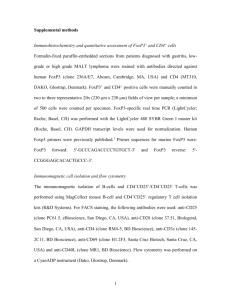
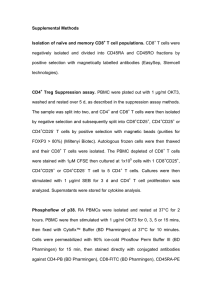
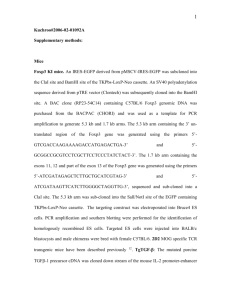
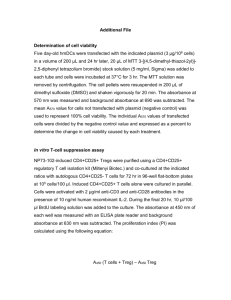

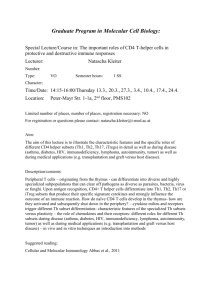
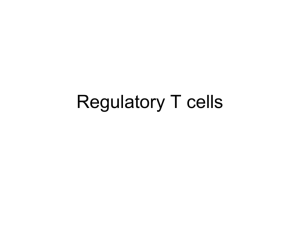

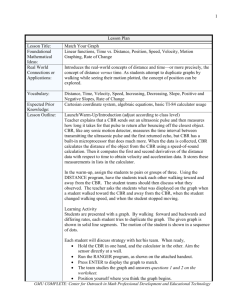
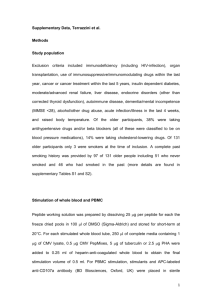
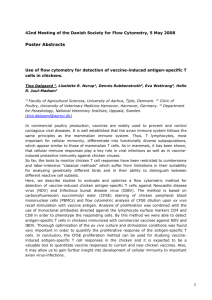
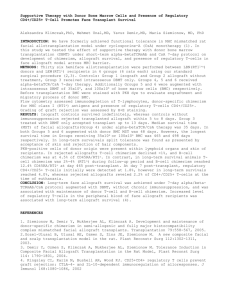

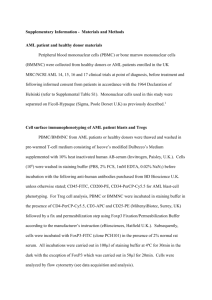
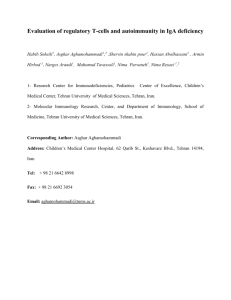
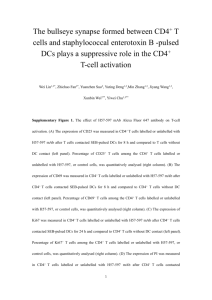
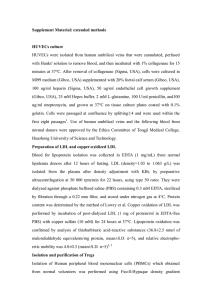
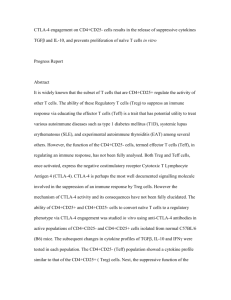
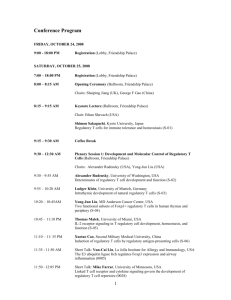
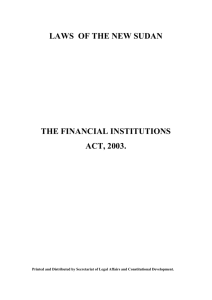
![The role of the CD[subscript 5]8 locus in multiple sclerosis Please share](http://s2.studylib.net/store/data/011696875_1-27a99c5713ba64263a223d9e9c30993f-300x300.png)
